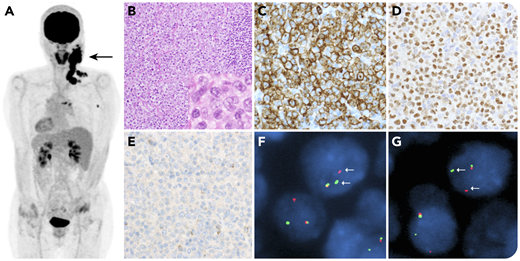A 69-year-old woman presented with cervical, mediastinal, and axillary lymphadenopathy (panel A, arrow). An excised specimen showed diffuse involvement by atypical large lymphoid cells, occasionally with kidney or horseshoe-like nuclei (panel B, hematoxylin and eosin, objective ×10, inset, objective ×40). These cells were positive for CD2, CD3, CD30 (panel C, objective ×40), and p63 (panel D, objective ×40), and negative for CD4, CD5, CD7, CD8, CD15, CD20, ALK, TIA-1 (panel E, objective ×40), and granzyme B. Diagnosis of anaplastic large cell lymphoma (ALCL), ALK-negative, was made. Surprisingly, fluorescence in situ hybridization identified the rearrangements of both DUSP22 (panel F) and TP63 (panel G). The patient achieved complete remission after cyclophosphamide, vincristine, doxorubicin, and prednisone therapy, and is without recurrence 7 months after diagnosis.
ALK-negative ALCL comprises a heterogeneous disease entity. Cases with DUSP22 or TP63 rearrangement are characterized by negativity of cytotoxic molecules or p63 expression, respectively. The former shows a much more favorable prognosis than the latter. Systemic ALCLs with both rearrangements have not ever been reported. The present case showed pathological findings of both molecular subtypes and had a complete response to chemotherapy, although follow-up remains limited. Further accumulation of similar cases is warranted to clarify this rare clinicopathological entity.
A 69-year-old woman presented with cervical, mediastinal, and axillary lymphadenopathy (panel A, arrow). An excised specimen showed diffuse involvement by atypical large lymphoid cells, occasionally with kidney or horseshoe-like nuclei (panel B, hematoxylin and eosin, objective ×10, inset, objective ×40). These cells were positive for CD2, CD3, CD30 (panel C, objective ×40), and p63 (panel D, objective ×40), and negative for CD4, CD5, CD7, CD8, CD15, CD20, ALK, TIA-1 (panel E, objective ×40), and granzyme B. Diagnosis of anaplastic large cell lymphoma (ALCL), ALK-negative, was made. Surprisingly, fluorescence in situ hybridization identified the rearrangements of both DUSP22 (panel F) and TP63 (panel G). The patient achieved complete remission after cyclophosphamide, vincristine, doxorubicin, and prednisone therapy, and is without recurrence 7 months after diagnosis.
ALK-negative ALCL comprises a heterogeneous disease entity. Cases with DUSP22 or TP63 rearrangement are characterized by negativity of cytotoxic molecules or p63 expression, respectively. The former shows a much more favorable prognosis than the latter. Systemic ALCLs with both rearrangements have not ever been reported. The present case showed pathological findings of both molecular subtypes and had a complete response to chemotherapy, although follow-up remains limited. Further accumulation of similar cases is warranted to clarify this rare clinicopathological entity.
For additional images, visit the ASH Image Bank, a reference and teaching tool that is continually updated with new atlas and case study images. For more information, visit http://imagebank.hematology.org.


This feature is available to Subscribers Only
Sign In or Create an Account Close Modal